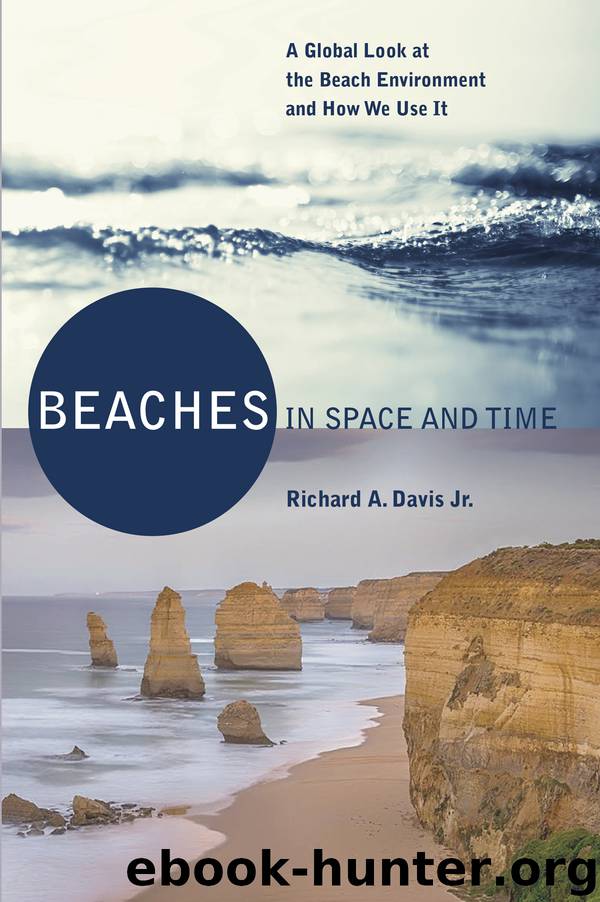Beaches in Space and Time by Dr. Richard A. Davis Jr

Author:Dr. Richard A. Davis Jr.
Language: eng
Format: epub
Publisher: Pineapple Press
Published: 2015-09-10T16:00:00+00:00
Figure 4.19
Heavy equipment moving borrow material into its proper place on the beach construction site
An even less costly and more simple nourishment approach is to remove the borrow material and transport it to a desired offshore site, commonly by hopper barge, then simply dump it at the desired depth and distance from shore. This would generally be only a few meters deep, because it is necessary for wave action to work on the sediment and carry it to the shoreline. Such a project was conducted at the southern portion of Padre Island, Texas, USA, with the sediment being placed at a depth of four meters. The borrow site was a ship channel a few kilometers away. The sediment was sucked into a hopper dredge, transported to the desired site, and dropped by opening the bottom of the dredge.
Nourishment Examples Beach nourishment projects are now being conducted throughout the world. The Atlantic Coast of the United States along with the entire Florida Peninsula has probably experienced the highest concentration of nourishment projects. Some of these have performed well, but others have not. Most of the poor performance of nourishment projects is due to the grain size of the borrow material and the wave energy, especially severe storms. Other parts of the world where nourishment has been used include Italy, Spain, the Netherlands, Denmark, China, Australia, and elsewhere. A few examples will provide some idea of how this all works.
Redington Beach, Florida, USA, provides a good picture of the before and after (figure 4.20) situation as well as the methodology of construction. This beach on the long, wave-dominated Sand Key barrier island on the west-central Florida Gulf Coast was eroding for several years, had a long vertical concrete seawall, and was in need of a major beach nourishment project. The borrow material was excavated by suction dredge from an ebb-tidal delta at Johns Pass, a nearby tidal inlet. It was pumped to the site and sculpted by machines as per the design plans. This was one of the first large nourishment projects on the Gulf Coast of the Florida Peninsula and was completed in 1988 (figure 4.20). It performed well and was followed by adjacent nourishment projects at each end of the initial one. Redington Beach has been subsequently renourished as was predicted.
Download
This site does not store any files on its server. We only index and link to content provided by other sites. Please contact the content providers to delete copyright contents if any and email us, we'll remove relevant links or contents immediately.
Man-made Catastrophes and Risk Information Concealment by Dmitry Chernov & Didier Sornette(5646)
The Revenge of Geography: What the Map Tells Us About Coming Conflicts and the Battle Against Fate by Kaplan Robert D(3961)
Zero Waste Home by Bea Johnson(3654)
In a Sunburned Country by Bill Bryson(3364)
COSMOS by Carl Sagan(3346)
Good by S. Walden(3345)
The Fate of Rome: Climate, Disease, and the End of an Empire (The Princeton History of the Ancient World) by Kyle Harper(2870)
Camino Island by John Grisham(2718)
A Wilder Time by William E. Glassley(2689)
Organic Mushroom Farming and Mycoremediation by Tradd Cotter(2565)
The Ogre by Doug Scott(2501)
Human Dynamics Research in Smart and Connected Communities by Shih-Lung Shaw & Daniel Sui(2431)
Energy Myths and Realities by Vaclav Smil(2380)
The Traveler's Gift by Andy Andrews(2298)
9781803241661-PYTHON FOR ARCGIS PRO by Unknown(2268)
Inside the Middle East by Avi Melamed(2230)
Birds of New Guinea by Pratt Thane K.; Beehler Bruce M.; Anderton John C(2175)
A History of Warfare by John Keegan(2101)
Ultimate Navigation Manual by Lyle Brotherton(2048)
